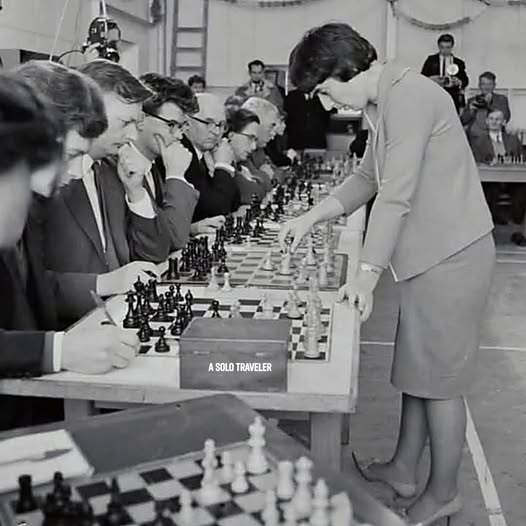
Meet Nona Gaprindashvili—the real-life chess queen Netflix tried to erase. While The Queen’s Gambit celebrated “Beth Harmon,” they conveniently “forgot” that Nona:
- 1962: Became the first woman ever to earn the title of International Grandmaster
- Defeated 59 male opponents in simultaneous exhibitions—28 of them fellow Grandmasters
- Won five consecutive Women’s World Championships (a record that still stands)
- Refused to compete for the overall World Championship when Soviet officials banned her from bringing along her young son
- At 79 years old, claimed gold at the Senior Team World Championship, proving age is just a number
In 2022, at age 80, she sued Netflix for \$5 million** for the on-screen claim that she “never faced men”—and won. Netflix publicly apologized and settled, but how many people even heard this story?
For decades, chess’s power brokers downplayed her achievements. Nona’s revenge? A legacy so powerful it outshines fiction.
Next time you watch The Queen’s Gambit, remember: the real Beth Harmon walked the board decades ago—and her true story is 100 times more incredible.
Nona Gaprindashvili: The Real-Life Queen’s Gambit Who Faced the World—and Won
In the world of chess, legends are often forged across 64 squares. Yet few stories transcend the board as powerfully as that of Nona Gaprindashvili—a woman who not only shattered records and stereotypes but also took on one of the most powerful media companies in the world to defend the truth of her legacy. While the Netflix series The Queen’s Gambit mesmerized millions with the fictional story of Beth Harmon, it inadvertently reawakened the world to the existence of a real-life chess queen who had already lived—and surpassed—that narrative decades earlier.
This is the story of Nona Gaprindashvili: the Georgian prodigy who faced down 59 male opponents, won five Women’s World Championships, and challenged the gender norms of a deeply patriarchal game. Her journey from the Soviet chess halls to the courtroom spotlight in 2022 is more than just a tale of brilliance and defiance—it is a statement that history cannot and should not be rewritten, especially when it comes to erasing women’s accomplishments.
I. Early Moves: The Rise of a Young Chess Prodigy
Born in 1941 in Zugdidi, a small town in the Republic of Georgia, then part of the Soviet Union, Nona Gaprindashvili’s path into chess was shaped by a culture that revered the game as both a science and an art. Georgia had a rich tradition of encouraging intellectual pursuits, and it wasn’t long before the young girl demonstrated a prodigious talent that could not be ignored.
By the age of 13, Nona had begun to draw national attention. Her aggressive style, deep understanding of strategy, and unshakable confidence stood out in a chess scene dominated by men. In an era when women were expected to play only in gender-segregated competitions, Nona broke the mold. She wasn’t just competing—she was winning, and often against adults and men far more experienced.
Her breakthrough came in 1962, when at just 21 years old, she won the Women’s World Chess Championship in Moscow, dethroning the reigning champion, Elizaveta Bykova. It wasn’t a close match—it was a domination. This victory marked the beginning of her reign over women’s chess, one that would last more than a decade.
II. A Queen Among Kings: Breaking Barriers in Men’s Chess
After her championship win, most would have expected Gaprindashvili to settle into the niche of women’s chess—a celebrated but often secondary arena. But Nona had other plans. She began entering open tournaments, where she faced—and regularly beat—male players, including grandmasters.
In 1978, she made history again when she became the first woman to earn the title of International Grandmaster, a title awarded regardless of gender and previously held only by men. This achievement was not symbolic—it was earned through hard-fought victories on the international circuit, including over top-tier male players. Her success forced FIDE, the world chess federation, to reevaluate the assumption that women could not compete at the highest levels of the game.
Perhaps her most symbolic achievement came during simultaneous exhibition matches, where she famously faced and defeated 59 male opponents, including 28 grandmasters. These exhibitions were more than publicity stunts—they were intellectual marathons requiring mental stamina and strategic brilliance. Her victories weren’t just on the board; they were cultural breakthroughs that challenged long-standing biases.
III. Challenges Behind the Scenes: Family, Politics, and Sacrifice
Nona’s career, like that of many Soviet athletes, was shaped by the geopolitical tensions of the Cold War. She was a public figure, a symbol of Soviet strength, and a woman navigating a male-dominated society. The pressure was intense.
Yet perhaps the most telling example of her personal sacrifice came when she was denied the opportunity to compete for the overall World Championship, a dream she had pursued for years. The reason? Soviet authorities refused to allow her to travel with her young son. Faced with an impossible choice between motherhood and ambition, Nona chose her family—but the loss of that opportunity was a bitter pill.
Still, she pressed on. Over the years, she would go on to win five Women’s World Championships and continue playing professionally well into her later life. In 2019, at the age of 79, she claimed gold at the Senior Team World Championship, proving her enduring brilliance. Age, like gender, was never a limit for her.
IV. The Queen’s Gambit: Netflix and the Revision of History
When The Queen’s Gambit premiered on Netflix in 2020, it was hailed as a triumph. The show told the story of Beth Harmon, a fictional orphan who rises to become the world’s best chess player. It celebrated a female protagonist in a male-dominated game and inspired a global resurgence of interest in chess.
But one moment in the final episode sparked outrage for those who knew the history of the game.
In the closing scenes, a chess commentator says, “There’s Nona Gaprindashvili, but she’s the female world champion and has never faced men.”
This statement wasn’t just false—it was defamatory. By the time this line aired, Gaprindashvili had spent decades facing—and beating—male players, making the claim both factually incorrect and deeply insulting.
Worse, the line was delivered while the show briefly showcased Gaprindashvili herself in a cameo, further reinforcing the falsehood as part of a factual narrative. The damage was immediate. For many viewers unfamiliar with real chess history, the line cemented a misunderstanding of her legacy.
V. Taking the King: Gaprindashvili Sues Netflix
At age 80, Nona Gaprindashvili did something remarkable—again. She filed a $5 million lawsuit against Netflix for defamation, stating that the line damaged her legacy and misrepresented her life’s work.
In the complaint, filed in a California federal court, her legal team argued that Netflix had made a “false statement of fact,” which defamed her reputation and diminished her achievements. The line in question, they contended, reinforced outdated gender stereotypes by suggesting that female chess players like Gaprindashvili could not or did not compete with men.
Netflix initially attempted to dismiss the lawsuit under the protection of artistic license, claiming the show was a work of fiction. But in a significant ruling, the judge allowed the suit to proceed, noting that even fictional works can be held liable if they contain defamatory statements presented as factual.
In 2022, the case was settled out of court, with Netflix agreeing to pay a confidential sum and issuing a public apology. While the financial terms remain undisclosed, the symbolic victory was clear: Nona Gaprindashvili’s name had been cleared, and her voice had cut through the fictional narrative.
VI. Fact vs. Fiction: The Ethics of Storytelling
The incident sparked wider debate about the ethical responsibility of storytellers, especially when blending fiction with historical fact. Should creators be allowed to alter or misrepresent real people’s legacies for the sake of narrative drama?
In this case, the line about Gaprindashvili was not necessary to the plot—it was a throwaway detail. But its impact was significant, particularly because the show itself had been celebrated for highlighting the struggles of women in chess. For many, it felt hypocritical to tell a story of female empowerment while simultaneously erasing the achievements of a real woman who had lived that very story.
Nona’s lawsuit wasn’t about money. It was about truth. It was about reclaiming her narrative and ensuring that future generations would know who she really was.
VII. Legacy of a Queen: Nona’s Enduring Impact
Nona Gaprindashvili’s influence on the game of chess cannot be overstated. She paved the way for countless women who came after her, including Judit Polgar, Hou Yifan, and other top-ranked female players who compete today in mixed-gender competitions.
In 1985, FIDE introduced the Gaprindashvili Cup, awarded to the national team with the best combined results in both the open and women’s sections of the Chess Olympiad. It remains one of the sport’s most prestigious honors and a permanent tribute to her impact.
Beyond titles and trophies, her life story has become a symbol of defiance, excellence, and perseverance. At every stage, she faced obstacles designed to keep her out: political pressure, gender discrimination, motherhood, and even modern media revisionism. She beat them all.
VIII. Conclusion: The Queen’s Real Gambit
In chess, the Queen’s Gambit is a bold opening—a sacrifice designed to secure long-term control. In life, Nona Gaprindashvili played her own gambits, sacrificing comfort, enduring setbacks, and challenging systems that underestimated her.
She was a queen in every sense: brilliant, commanding, strategic, and fearless.
The next time someone marvels at Beth Harmon’s fictional journey, let them also marvel at Nona’s very real one. Her story wasn’t written in a script—it was lived, piece by piece, battle by battle, and truth by truth.
And thanks to her courage—both on the board and in the courtroom—the world will remember her not as someone who “never faced men,” but as the woman who faced the world and won.


